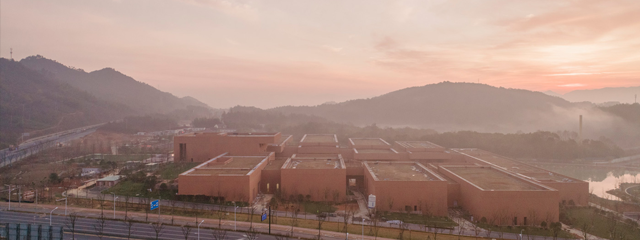Founded in 1929, the Zhejiang Museum of Natural History is located in Hangzhou and has a collection of over 200,000 specimens covering geology, ecology and palaeontology. The eastern Chinese province is the site of many important discoveries from the Cretaceous period. This new, second branch of the museum is the centrepiece of a cultural district in Anji, a relatively rural area in north Zhejiang. The high number of anticipated visitors and the large scale of some of the exhibits, gave rise to a loose infrastructure of spacious exhibition halls.
The new museum is set on a sloping site in a large natural park surrounded by bamboo forests and overlooking rice fields in the valley below. A staggered composition of eight, single-storey, bar-shaped pavilions step down the hillside. They follow the natural topography, minimising the visual impact on the landscape, and frame an open garden. A loggia, or covered walkway, loops around this central space, mediating between the external and internal areas of the museum.
At the northernmost point, an entrance pavilion welcomes visitors and offers views over the central garden and landscape beyond. Located on either side of the garden, each exhibition hall can be accessed directly or in sequence following the stepped loggia. The southernmost pavilion, housing education facilities, faces out towards a lake at the lowest end of the site.
The solid forms of the pavilions are embedded within the dense landscaping of the central garden and the surrounding parkland. The planting extends onto the green roofs of the building complex which is rendered in red ochre to match the clay earth of the hillside site, reinforcing the relationship between the museum and the landscape.
















